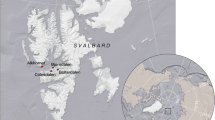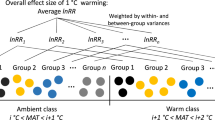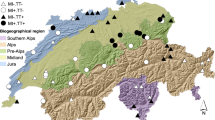Abstract
The Arctic soil organic-carbon pool is a significant, but poorly constrained, carbon store. The most cited pool size estimates are based on a study that severely undersamples Arctic soils, with only five out of the 48 soils examined actually from the Arctic region. Furthermore, previous measurements have been confined to the top 40 cm of soil. Here, we present 1-m-deep measurements of soil organic carbon obtained at 117 locations in the North American Arctic region. To this dataset we add previously published measurements to generate a total sample size of 139 North American Arctic soils. We show that soil organic-carbon stores are highly dependent on landscape type, being highest in lowland and hilly upland soils, where values average 55.1 and 40.6 kg soil organic carbon m−2 respectively, and lowest in rubbleland and mountain soils, where values average 3.4 and 3.8 kg soil organic carbon m−2 respectively. Extrapolating our measurements using known distributions of landscape types we estimate that the total organic carbon pool in North American Arctic soils, together with the average amount of carbon per unit area, is considerably higher than previously thought. Our estimates of the depth distribution and total amount of organic carbon in North American Arctic soils will form an important basis for studies examining the impact of climate warming on CO2 release in the region.
This is a preview of subscription content, access via your institution
Access options
Subscribe to this journal
Receive 12 print issues and online access
$259.00 per year
only $21.58 per issue
Buy this article
- Purchase on Springer Link
- Instant access to full article PDF
Prices may be subject to local taxes which are calculated during checkout


Similar content being viewed by others
References
French, H. M. The Periglacial Environment 2nd edn (Longman, White Plains, 1996).
Chernov, Y. I. & Matveyeva, N. V. in Ecosystems of the World, Polar and Alpine Tundra (ed. Wielgolaski, F. E.) 361–506 (Elsevier, Oslo, 1997).
Tarnocai, C. & Smith, C. A. S. Proc. 1st Int. Conf. on Cryopedology 21–42 (Russian Academic of Sciences, Pushchino, 1992).
Ping, C. L., Bockheim, J. B., Kimble, J. M., Michaelson, G. J. & Walker, D. A. Characteristics of cryogenic soils along a latitudinal transect in Arctic Alaska. J. Geophys. Res. 103, 28917–28928 (1998).
Walker, D. A. et al. Frost-boil ecosystems: complex interactions between landforms, soils, vegetation, and climate. Permafrost Periglacial Proc. 15, 171–188 (2004).
Bliss, L. C. & Svoboda, J. Plant communities and plant production in the western Queen Elizabeth Islands. Holarct. Ecol. 7, 325–344 (1984).
Tedrow, J. C. F. Soil of the Polar Regions (Rutgers Univ. Press, New Brunswick, 1974).
Michaelson, G. J. & Ping, C. L. Soil organic carbon and CO2 respiration at subzero temperature in soils of arctic Alaska. J. Geophys. Res. 108, 8164 (2003).
Bockheim, J. B., Walker, D. A., Everett, L. R., Nelson, F. E. & Shikolmanov, N. I. Soils and cryoturbation in moist nonacidic and acidic tundra in the Kuparuk river basin arctic Alaska, USA. Arct. Alp. Res. 30, 166–174 (1998).
Peterson, R. A. et al. in Permafrost: Proc. Eighth Int. Conf. on Permafrost Vol. 2 (eds Phillips, M., Springman, S. M. & Arenson, L. U.) 885–890 (A. A. Balkema Publishers, Lisse, 2003).
Ping, C. L. et al. Cryogenesis and soil formation along a bioclimate gradient in Arctic North America. J. Geophys. Res. 113, doi:10.1029/2008JG000744 (2008).
Davidson, E. A. & Janssens, I. A. Temperature sensitivity of soil carbon decomposition and feedbacks to climate change. Nature 440, 165–173 (2006).
Jobbagy, E. G. & Jackson, R. B. The vertical distribution of soil organic carbon and its relation to climate and vegetation. Ecol. Appl. 10, 423–436 (2000).
Jones, C. et al. Global climate change and soil carbon stocks; predictions from two contrasting models for the turnover of organic carbon in soil. Glob. Change Biol. 11, 154–166 (2005).
Post, M. W., Emanuel, W. R., Zinke, P. J. & Stangenberger, G. Soil carbon pools and world life zones. Nature 298, 156–159 (1982).
Sturm, M. et al. The role of winter biological processes in converting arctic tundra to shrubland. Bioscience 55, 17–26 (2005).
Hobbie, S. E. et al. Controls over carbon storage and turnover in high-latitude soils. Glob. Change Biol. 6, 196–210 (2000).
Romanovsky, V. E. et al. Proc. Second Russian Conf. on Geocryology 301–314 (Permafrost Science, Moscow, 2001).
Osterkamp, T. E. & Jorgenson, J. C. Warming of Permafrost in the Arctic National Wildlife Refuge, Alaska. Permafrost Periglacial Proc. 17, 65–69 (2006).
Walker, D. A. et al. The circumpolar vegetation map. J. Vegetat. Sci. 16, 267–282 (2005).
Chapin, F. S. III, Miller, P. C., Billings, W. D. & Coyne, P. I. in An Arctic Ecosystem: The Coastal Tundra at Barrow, Alaska (eds Brown, J., Miller, P. C., Tieszen, L. L. & Bunnnell, F. L.) 458–486 (Dowden, Hutchison and Ross, Stroudsburg, 1980).
Oechel, W. C. & Billings, W. D. in Arctic Ecosystems in a Changing Climate (eds Chapin, F. S. III, Jefferies, R. L., Reynold, J. F., Shaver, G. R. & Svoboda, J.) 139–168 (Academic, San Diego, 1992).
Stolbovoi, V. Carbon in Russian soils. Clim. Change 55, 131–156 (2002).
Douglas, L. A. & Tedrow, J. C. F. Transactions of the 7th Int. Congr. on Soil Science Vol. 4, 291–304 (1960).
Tarnocai, C. in Global Climate Change and Cold Regions Ecosystems (eds Lal, R., Kimble, J. M. & Stewart, B. A.) 91–103 (Advances in Soil Science, Lewis Publishers, Boca Raton, 2000).
Kimble, J. M. et al. in Proc. Joint Russian–American Seminar on Cryopedology and Global Change (ed. Gilichinsky, D. A.) 277–291 (Russian Acad. of Sci., Inst. of Soil Sci. and Photosynth., Pushchino, 1993).
Michaelson, G. J., Ping, C. L. & Kimble, J. M. in Assessment Methods for Soil Carbon (eds Lal, R., Kimble, J. M., Follet, R. F. & Stewart, B. A.) (Advances in Soil Science, CRC Lewis Publishers, Boca Raton, 2001).
Shur, Y., Hinkel, K. & Nelson, F. The transient layer: Implications for geocryology and climate-change science. Permafrost Periglacial Proc. 16, 5–7 (2005).
Ping, C. L., Michaelson, G. J. & Kimble, J. M. Carbon storage along a latitudinal transect in Alaska. Nutr. Cycling Agroecosyst. 49, 235–242 (1997).
Washburn, A. L. Geocryology: A Survey of Periglacial Processes and Environments (Wiley, New York, 1980).
Goryachkin, S. V. et al. in Cryosols: Permafrost-Affected Soils (ed. Kimble, J.) 49–70 (Springer, Berlin, 2004).
Hoefle, C. M., Ping, C. L. & Kimble, J. M. Properties of permafrost soils on the Northern Seward Peninsula, Northwest Alaska. Soil Sci. Soc. Am. J. 62, 1629–1639 (1998).
Acknowledgements
The following National Science Foundation projects contributed to this work: Arctic Transitions in the Land-Atmosphere System, the Flux Study, Biocomplexity of the Arctic System, and Arctic Coastal Transfer. Also significant contributions from the US Department of Agric. Hatch Project and Global Change Initiative, and Hilmar Maier for help with mapping data.
Author information
Authors and Affiliations
Contributions
C.L.P. initiated, conceived and coordinated the paper; G.J.M. contributed to the concept, data analysis and writing; M.T.J., J.M.K., H.E., V.E.R. and D.A.W. contributed to data collection and writing.
Corresponding author
Supplementary information
Supplementary Information
Supplementary table S1 (PDF 401 kb)
Rights and permissions
About this article
Cite this article
Ping, CL., Michaelson, G., Jorgenson, M. et al. High stocks of soil organic carbon in the North American Arctic region. Nature Geosci 1, 615–619 (2008). https://doi.org/10.1038/ngeo284
Received:
Accepted:
Published:
Issue Date:
DOI: https://doi.org/10.1038/ngeo284
This article is cited by
-
Permafrost degradation and its consequences for carbon storage in soils of Interior Alaska
Biogeochemistry (2024)
-
Dominance of particulate organic carbon in top mineral soils in cold regions
Nature Geoscience (2024)
-
Photo-produced aromatic compounds stimulate microbial degradation of dissolved organic carbon in thermokarst lakes
Nature Communications (2023)
-
Future projection of greenhouse gas emissions due to permafrost degradation using a simple numerical scheme with a global land surface model
Progress in Earth and Planetary Science (2020)
-
Spatial patterns in soil organic matter dynamics are shaped by mycorrhizosphere interactions in a treeline forest
Plant and Soil (2020)



